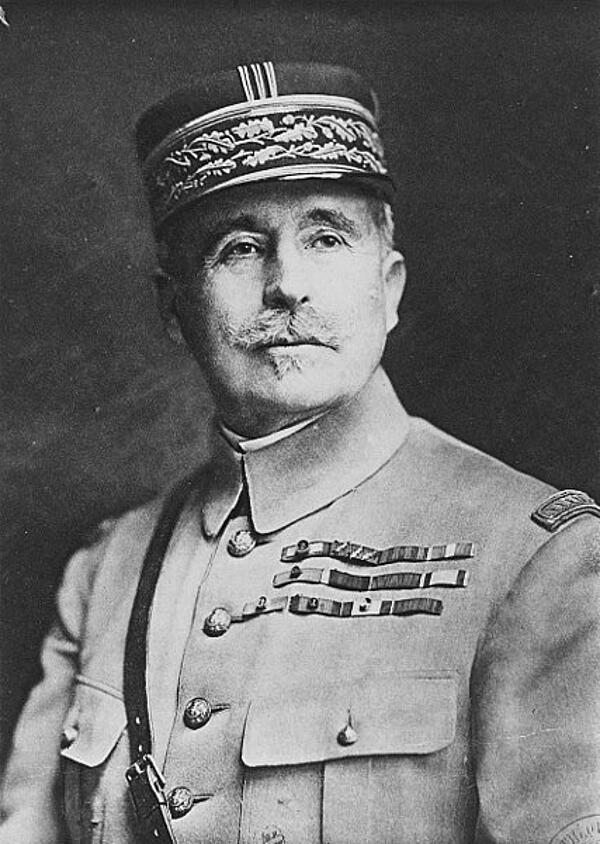Robert Nivelle
Robert Nivelle was born on 15th October 1856. He joined the French Army in 1878 and soon began to specialise in artillery warfare, gaining much experience and earning a reputation in campaigns in Algeria, China and Tunisia. In fact, by 1913 he was made a colonel in the artillery division.
When the Germans threatened to defeat French forces at the Marne and to take Paris in 1914, it was Nivelle’s first opportunity to contribute to the Allied war effort. While many different reasons why the Germans were stopped, but Nivelle’s organisation of the artillery fire (both at Marne and at the First Battle of Aisne) was certainly one of them.
As a result of Niville’s actions, he was promoted to general in October 1914 in recognition of his achievements, and eventually he succeeded Pétain as commander of the French Second Army who was fighting (and losing) in Verdun.

The Battle of Verdun was where Nivelle really made his name. Both sides were rapidly losing men and the campaign was beginning to look like a disaster. By choosing to bypass traditional artillery and use a sort of creeping barrage instead, Nivelle was able to protect the infantry soldiers on the ground - saving many lives and boosting morale significantly.
As a result of his actions he gained a reputation as a caring commander, which had a long term effect on the success of the French Army. However, Germany still had an upper hand in terms of numbers and on 23rd June 1916, Fleury was captured. Nivelle responded by issuing an order that ended ‘they shall not pass’, winning over the politicians with his spirit.
By the end of October 1916, Fleury had been recaptured, along with the fort at Douaumont, and Nivelle was a national hero. He was appointed Commander-in-Chief of the French Army on 16th December 1916.
Sadly, Nivelles glory did not last long. In the spring of 1917, Nivelle launched what became known as the Nivelle Offensive. This action was based on his belief that the enemy should always be bombarded with artillery before an attack, leaving them weak ahead of an infantry assault supported by a creeping artillery barrage used for protection. Nivelle believed this plan would work once more on the German lines at the Aisne and that they would be destroyed within just two days, and with only 10,000 casualties.
Many French commanders were concerned by the plans, which they saw as far too simplistic and failing to take into account the solid position of the Germans. In fact, even Haig, who was in command of a British and Commonwealth attack on Arras and Vimy Ridge as part of the Nivelle’s plans, was not sure it would be a success. However, Nivelle had managed to secure support at the very highest level, including Aristide Briand, the French Prime Minister and President Poincare, although the latter still demonstrated concern and said they should withdraw if they suffered one failed attempt.
Nivelle stood by his beliefs and decided against changing his plans, even when he discovered that a copy had likely been stolen by the Germans during an attack on French positions in the April before. Unsurprisingly, the Nivelle Offensive on the Germans along the River Aisne was a failure, leading to mutiny in 68 our of 112 French divisions. This wasn’t helped by the fact that the military failed to deal with the French wounded who had to remain on the front, which ensured morale plummeted.
It wasn’t long before senior officers began question Nivelle’s Offensive, and on 29th April Pétain was appointed Chief of the General Staff. Less than one month later, Nivelle was sacked and Pétain was made Commander-in-Chief of the French Army. However, the change came too late, and by the end of the Offensive, France had lost 5,250 men everyday for two weeks - a total of 187,000 men.
While more men had been lost at Verdun, Nivelle’s claims that only 10,00 lives would be lost made his fall just as large. In December 1917, he was told to serve with the French Army in North Africa and wouldn’t return until the end of World War One. He eventually retired from the army in 1921 and died on 22 March 1924.
MLA Citation/Reference
"Robert Nivelle". HistoryLearning.com. 2026. Web.
